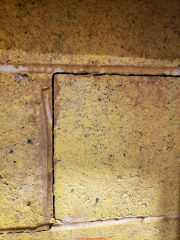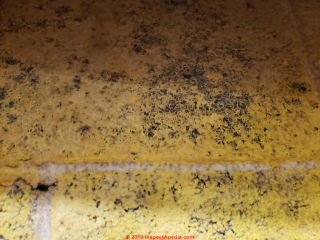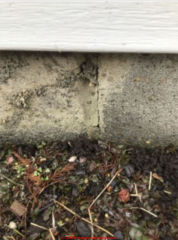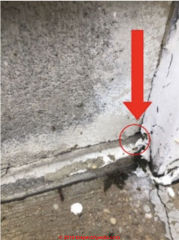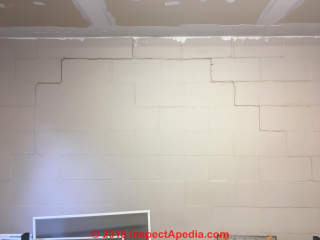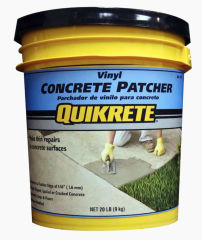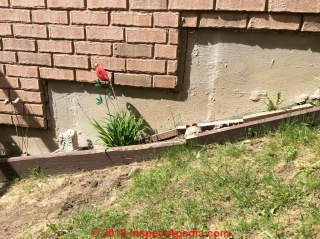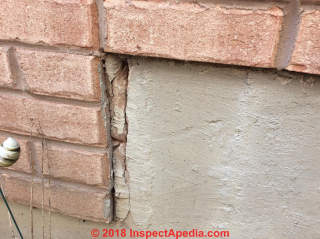 Block Foundation Wall Cracks FAQs-2
Block Foundation Wall Cracks FAQs-2
- POST a QUESTION or COMMENT about damaged concrete block foundations: causes, crack & movement patterns, diagnosis, repair, inspection procedures
Q&A on damaged masonry block foundations & walls set#2.
FAQs on the diagnosis & repair of damaged masonry block foundations & walls.
This article series explains the types of foundation cracks, crack patterns, differences in the meaning of cracks in different foundation materials, site conditions, building history, and other evidence of building movement and damage.
Types of foundation damage are described to assist in recognizing foundation defects and to help the inspector separate cosmetic or low-risk conditions from those likely to be important and potentially costly to repair.
InspectAPedia tolerates no conflicts of interest. We have no relationship with advertisers, products, or services discussed at this website.
Masonry Block (concrete & "cinder block") Foundation & Wall Damage Q&A-2
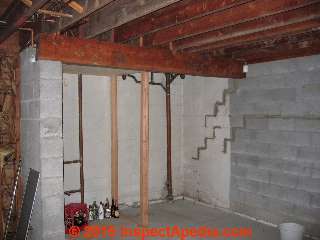
These questions and answers about how to evaluate the type and extent of damage to a concrete block wall or foundation ("cinder blocks" or "masonry blocks") were posted originally at BLOCK FOUNDATION & WALL DEFECTS - home - be sure to review that article.
On 2020-02-19 - by (mod) - step cracking & mold in / on painted concrete block foundation wall
Pete
It'd be no surprise to find some mold growth on concrete block foundation walls, particularly where paint has been applied but also where there may be organic dust and debris.
The stair step crack pattern is often related to settlement or to frost heaves.
Take a look outside the same area for roof spillage, surface runoff, and take a look inside for a history of water entry.
Then you'll want to review FOUNDATION DAMAGE SEVERITY inspectapedia.com/structure/Foundation_Damage_Assessment.php
As I don't see obvious extensive water entry signs in your photo - such as rotted sill plates - it's possible that the mold is related to moisture penetration into what was a fiberglass-insulated wall cavity against cool concrete block foundation walls.
"Crystallization" or properly, "effloresence" is a mineral salt that is left on masonry as water evaporates from its surface. Your photos don't look like that to me though I cannot, of course, see everything.
See EFFLORESCENCE SALTS & WHITE DEPOSITS for details.
On 2020-02-19 by pete
sorry one more
Another pic of the cinderblock
On 2020-02-19 by pete - assessment on this cinder block...
Wondering your assessment on this cinder block...we had a water leak in the corner so we took down the drywall and the insulation and this is what we see.
Looks like someone painted it yellow but a contractor told us that is not mold but appears to be a crystallization?
I have a couple more pics but it looks like you only allow one upload.
Thanks

On 2020-01-22 - by (mod) - assess problems with water entry and foundation damage
Esther
I'll be glad to assist, though I think we'll need more details to be very prescriptive.
On an older home it's common that footing drains, even if installed, no longer work as they become clogged.
A trench along the foundation wall wants to trap roof spillage against the foundation, increasing the rate of water entry;
So the first priority is to get the gutters and leaders working to get water away from the house.
I can't tell you what damage repair is needed without knowing the extent of damage of the existing wall and its effect on the rest of the structure.
As a ***VERY*** general guideline, because of the risk that a buckled concrete wall can collapse, at a series of foundation inspection conferences we polled home inspectors, engineers, architects, masons, about "how much bulge is enough to flag as significant movement" in a block wall. The consensus was about an inch.
Please read FOUNDATION DAMAGE SEVERITY
and don't hesitate to post photos (one per comment) and to ask follow-up questions.
On 2020-01-22 by Esther
This house is in Mississippi. My father passed away in Dec. and gave the house to me.
My father's house is built with a partially exposed basement (built on a hill). The front basement wall is retaining water when it rains a lot and the ground is saturated. It has started to leak into the inside walls, therefore the mortar is disintegrating some between the cement blocks
. He had someone dig a small trench between bushes planted in front of the house and the house. These bushes have been there a long time and have thick roots. I have been told that gutters would probably prevent this problem from continuing to happen. But how do I fix the damage that has already been done?
On 2020-01-12 - by (mod) - concrete garden wall collapsed
Trisha
Thanks for an interesting question.
I can't see enough to have a reliable opinion about why your garden wall collapsed, but **IF** in moving a mobile home into place OR in building the concrete pad below the home heavy equipment drove by or dug next the wall that might have affected its supporting footing.
On 2020-01-12 by Trisha
Hi concrete garden wall collapsed just wondering would it have anything to do with we have a mobile home exactly alongside we’re the wall collapsed?
On 2020-01-10 by (mod) - The sellers have refused to have a free foundation inspection
Kudos to your inspector for looking carefully;
I can't see enough to offer a confident opinion. I suspect the total cracking and movement are minor but must add that on-site there will ALWAYS be important additional information that simply didn't show up in reports or photos.
I have no distant views, no context, no interior views, no clues about extent of impact on the structure of any cracks or movement - things a structural engineer would consider (I'm not one).
I did notice what looks like a downspout extension (new) near a crack in a photo and I noticed what looks like a slab abutting the foundation that's cracked in a line approaching the crack in the block wall (or whatever it is); those are hints at frost heaves.
On 2020-01-10 by Melandharris
This shows some diagonal cracking but it looks minor. Let us know if you think it’s major or not. Thank you so much!
On 2020-01-10 by MelandHarris
Here is an additional photo. We think this may be shear failure but we’re not sure
On 2020-01-10 by MelandHarris
We would like to buy a house but the general inspector advised we should get a foundation contractor to give a professional opinion on the cracks/things he observed with the CMU block.
The sellers have refused to have a free foundation inspection (or anything else) done with the home.
Please take a look at the following pictures and help us decide If this is too risky a purchase or if this is common for a house built in 1998. It’s also about 50ft from a man made lake.
Please let us know what the worst case scenario is either now or in the future based on the issues observed in these photos. Any help would be greatly appreciated! Thank you!
On 2020-01-03 - by (mod) - evidence of dislocated foundation and prior repairs
Lisa
that indeed looks odd, but those half-blocks might indicate some prior repair or extension of the foundation. Be sure to discuss this with your home inspector who will be able to see much more than I can in the photo.
On 2020-01-02 2 by Lisa
Hello, Please see the attached photo. I am interested in buying this house.
From the outside I can see the block looks shifted or just laid down offset. I can provide more information but it is not easy to describe where this is taken.
It's in the basement, but taken inside another wall. (Circular hole in wall for pipe or air vent. Photo taken from open area inside the hole cut out area.)
Thank you.
On 2018-10-12 by (mod) - what to do about deteriorating cinderblocks
Joan
Losing surface material, or "spalling" on concrete blocks may mean damage from water, rain splash-up (roof spillage), frost, combined with older or soft low-concrete mix when the blocks were made
Cracking is a different matter: the size, shape, position, length, width, pattern of cracking along with total extent of movement are evaluated to decide what kind of repair is needed.
In extreme cases such as a wall leaning in 3" or more at the top or bulged in center, there is risk of collapse and you need more-urgent evaluation and help.
You might try calling an experienced mason who is familiar with block construction.
You can also add an image to a comment to show us what you see.
On 2018-10-12 by JoAN
We have a cinder block house that is showing cracks, come sloughing off of "concrete" -
Who can we call to fix it? Is there a temporary fix we can do before winter and finding
a professional?
On 2018-09-16 by (mod) - horizontal crack on just one mortar seam
Paul
Before trying any seal repair it would be best to evaluate the extent of cracking and its impact on the structure, thus to permit a distinction among steps for sealing a crack, fixing a water or frost problem, repairing structural damage, or something more extensive like foundation rebuild.
I can't guess at those from your question alone.
On 2018-09-16 by Paul olsav
i have a horizontal crack on just one mortar seam the whole length of the house. is a polyurethane sealer best or fill crack with mortar?
On 2018-07-25 by (mod) - how bad is the pyramid-shaped stepped cracked concrete block wall damage?
When there is a pyramid-shaped or stair-stepped cracking near the center of a concrete block foundation wall, and more-so if the wall is also pushed inwards, there is risk of continued damage and even foundation wall collapse.
The urgency of attending to this wall is unclear as we don't know the crack history, age, rate of change, nor outdoor conditions that cause it such as improper drainage, water, frost, vehicle loading, earth loading.
I'd be concerned enough to want to understand the cause of the damage seen, its effect on the rest of the structure, when it happened, and whether or not it's on-going. If so repair would be needed.
If the damage occurred by some nitwit driving too close to the foundation during backfill - as the pattern could indicate - and if the damage is old and was patched and there was no further movement,
AND IF the total amount of movement is not enough that one would worry about a wall collapse or damage to the structure (opinions vary but an inch or more of inwards lean might be a concern),
THEN the wall worry gets downgraded to "keep an eye on it".
On 2018-07-25 y Cambar3
When we purchase our home in 2012, these are the cracks in the mortar. You can see where some have been caulked before. Inspector at that time said it was fine. Are these a concern?
On 2018-07-25 by (mod) - using Quikrete to patch mortar?
Andrew
You're showing a stepped foundation down a steep hill. I cannot see the foundation material but I suspect it's poured concrete.
All but one of the cracks in your photos are where the brick veneered (perhaps over frame) portions of the structure abut the stepped foundation - if so that's not foundation movement; it's a seal-job.
Flexible sealants will be more durable in such a location because they'll handle the differences in thermal expansion of the different materials involved.
One vertical crack near the wall bottom *could* be foundation movement and bears further scrutiny.
I'm not sure you'll get a good bond of Quikrete over a polyurethane sealant. That's why you'd want to color match it.
BTW it looks to me as if the cracks you see may be at an abutment of wood framed walls to a stepped concrete foundation.
If so the cracking would be no surprise there as the materials differ in their response to thermal and moisture changes. THat's why a flexible sealant may perform better than simple concrete or mortar patch.
On 2018-05-11 by Andrew
So you do not think mortar crammed into the space then parged... not the best way. But a poly capped with the quikrete is best?
On 2018-05-11 by (mod) - what to use to patch recurrent cosmetic cracks at differing materials
You can use Quikrete as a patching material if the surface that you're applying it to is clean and dry.
However if you use a flexible sealant your patch will be more resistant to re cracking from minor amounts of ongoing movement.
On 2018-05-11 by Andrew - what should I use to patch these cracks?
So right now all I have is some quikete quick setting cement. Should I take it back and get mortar? A polyurethane filler and parge? I’m a complete novice here so...
...
On 2018-05-11 by (mod) -
Right you can add one photo per comment course you can make multiple photo postings by making multiple comments. I don't think the software will let you post a video
On 2018-05-10 by Andrew
I did a video and uploaded it. I guess it didn’t play?
1. I will look at the article
2. The cracks have been there for a long time but only recently noticed that they are straight through. (Basement is unfinished so I looked behind insulation and saw daylight.
3. No movement since settling after year 2. (I bought house from the dirt)
I will send more pics but this only seems to let me add one. Am I wrong?
On 2018-05-10 by (mod) - Ontario there could be frost heave or frost damage.
Ah so in Ontario there could be frost heave or frost damage.
If you don't see cracks in the basement, nor water entry,
If you don't see foundation movement, leaning, bulging, bowing, and/or related movement in the rest of the structure (such as drywall cracks or sticking doors/windows traced to building movement)
then most-likely this isn't a structural problem. Of course NOBODY can, from a brief and necessarily very incomplete exchange of a few text lines, claim to have made a thorough building assement nor diagnosis. There is, however, more detailed advice in the article I suggested. That'll help you decide if you need to bring in an expert.
On 2018-05-10 by (mod) -
"same place" and "each rise" are unclear to me. Maybe some photos showing context would help.
On a 17 year old town home one would want to know
- is this crack new or old,
- recurrent or static,
Using the on-page InspectApedia search box just above to look for "foundation damage assessment" finds FOUNDATION DAMAGE SEVERITY - at https://inspectapedia.com/structure/Foundation_Damage_Assessment.php
How to Evaluate the Significance or Amount of Foundation Movement when a foundation is leaning, bulging, bowing, or settling.
I recommend that article.
On 2018-05-10 by Andrew
Soil is very sandy and drains well. Walkout basement and I said in my initial question that it is a poured concrete foundation. This is in south central Ontario.Barrie to be precise.
It is above grade... with a slope rising to the front of the house. The cracks are in the same place on each rise and nowhere else.
On 2018-05-10 by (mod) - information needed to evaluate a crack in unknown material abutting brick (veneer?) exrterior wall
I can't see enough from your photo - though it's a good one - to have any context.
So I don't know how the building is constructed (frame, brick veneer, solid brick, concrete foundation, concrete block foundation), basement, crawl space, slab on grade, nor surrounding site and location (expansive clay, wet soils, bad footings, inslope grade, building movement, etc).
So I'm unsure if what we see is trivial such as mortar shrinkage that can just be sealed, or if the building is moving.
If the only crack is the one in your photo, seal it with another coating of foundation sealer and watch it for change.
On 2018-05-09 by Anonymous - crack in masonry abutting brickwork
I I have a 17-year-old above grade townhome joined on one side by common wall the above grade is poured concrete foundation with brick to vinyl siding where the brick is my Joyner between the foundation and the vinyl.
The cracks seem to be where the mortar connects the brick to the foundation and even then only on the verticals. There are NO cracks in the foundations themselves and the bricks are all sound. Unfortunately the crack/separation opens a dimed width gap into my house.letting insects and potentially moisture in. What do I do to repair?
On 2018-01-14 by (mod) - During hurricane IRMA 2017 we had a large oak impact our roof resulting in 70% or more of our masonry joints showing cracks
John, I agree that your question is a reasonable one, but it's not one that anybody with any sense can assess by an e-text.
An onsite expert is needed. We don't know if your wall is a veneer or a structure. If it's a structural wall and bond courses are broken, a cosmetic repair is not likely to be adequate.
If the wall is a veneer wall and veneer connections to the building are broken the veneer will not be secured simply by re-filling cracks.
I would start, then by asking your onsite expert (an engineer or mason with expertise and experience with residential masonry wall construction and repair) what kind of wall is involved, how the damage affects the structure, and/or how she concludes that the damage is only cosmetic, permitting a surface repair.
On 2018-01-12 by John french
During hurricane IRMA 2017 we had a large oak impact our roof resulting in 70% or more of our masonry joints showing cracks along verticle and horizontal lines along with stair step cracking throughout structure as well. Insurance ignored it stating ground settlement which I contested with an engineers report stating the obvious tree impact.
My question is what to do now. Everybody is willing to fix it but the repair seems superficial if they are only grinding the outside cracks and repairing them.
In my opinion as home owner this would not be returning the house to prior condition. I need help please advise. Can gladly forward any information needed.
...
Continue reading at BLOCK FOUNDATION & WALL DEFECTS or select a topic from the closely-related articles below, or see the complete ARTICLE INDEX.
Or see these
Recommended Articles
- BLOCK FOUNDATION & WALL DEFECTS - home
- BLOCK WALL INSULATION RETROFIT
- CONCRETE or MASONRY DAMAGE TESTS
- FOUNDATION CRACK DICTIONARY for descriptions of different crack patterns, causes, repairs
- FOUNDATION DAMAGE & REPAIR GUIDE - home
- FOUNDATION DAMAGE SEVERITY
- FOUNDATION INSPECTION STANDARDS
Suggested citation for this web page
BLOCK FOUNDATION WALL DAMAGE FAQs-2 at InspectApedia.com - online encyclopedia of building & environmental inspection, testing, diagnosis, repair, & problem prevention advice.
Or see this
INDEX to RELATED ARTICLES: ARTICLE INDEX to BUILDING STRUCTURES
Or use the SEARCH BOX found below to Ask a Question or Search InspectApedia
Ask a Question or Search InspectApedia
Questions & answers or comments about damaged concrete block foundations: causes, crack & movement patterns, diagnosis, repair, inspection procedures..
Try the search box just below, or if you prefer, post a question or comment in the Comments box below and we will respond promptly.
Search the InspectApedia website
Note: appearance of your Comment below may be delayed: if your comment contains an image, photograph, web link, or text that looks to the software as if it might be a web link, your posting will appear after it has been approved by a moderator. Apologies for the delay.
Only one image can be added per comment but you can post as many comments, and therefore images, as you like.
You will not receive a notification when a response to your question has been posted.
Please bookmark this page to make it easy for you to check back for our response.
Our Comment Box is provided by Countable Web Productions countable.ca
Citations & References
In addition to any citations in the article above, a full list is available on request.
- In addition to citations & references found in this article, see the research citations given at the end of the related articles found at our suggested
CONTINUE READING or RECOMMENDED ARTICLES.
- Carson, Dunlop & Associates Ltd., 120 Carlton Street Suite 407, Toronto ON M5A 4K2. Tel: (416) 964-9415 1-800-268-7070 Email: info@carsondunlop.com. Alan Carson is a past president of ASHI, the American Society of Home Inspectors.
Thanks to Alan Carson and Bob Dunlop, for permission for InspectAPedia to use text excerpts from The HOME REFERENCE BOOK - the Encyclopedia of Homes and to use illustrations from The ILLUSTRATED HOME .
Carson Dunlop Associates provides extensive home inspection education and report writing material. In gratitude we provide links to tsome Carson Dunlop Associates products and services.


